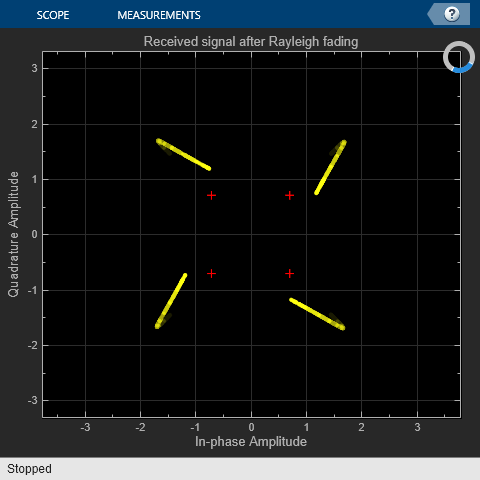Multipath Fading Channel in Simulink
This model shows how to use the SISO Fading Channel block from the Communications Toolbox™ to simulate multipath Rayleigh and Rician fading channels, which are useful models of real-world phenomena in wireless communications. These phenomena include multipath scattering effects, time dispersion, and Doppler shifts that arise from relative motion between the transmitter and receiver. The model also shows how to visualize channel characteristics such as the impulse and frequency responses, Doppler spectrum and component gains.
Model and Parameters
The example model simulates QPSK transmission over a multipath Rayleigh fading channel and a multipath Rician fading channel. Both the channel blocks are configured from the SISO Fading Channel library block. You can control transmission and channel parameters via workspace variables.
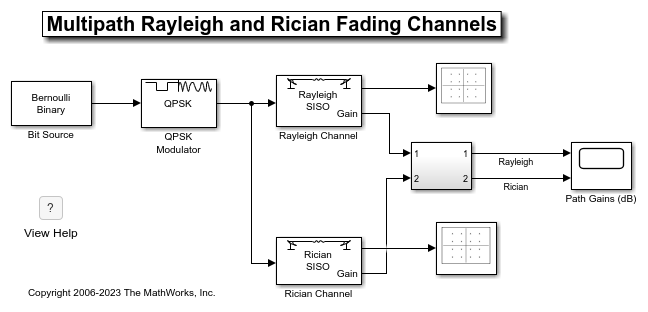
The following variables control the "Bit Source" block. By default, the bit rate is 10M b/s (5M sym/s) and each transmitted frame is 2000 bits long (1000 symbols).
bitRate =
10000000
bitsPerFrame =
2000
The following variables control both the Rayleigh and Rician fading channel blocks. By default, the channels are modeled as four fading paths, each representing a cluster of multipath components received at around the same delay.
delayVector =
1.0e-06 *
0 0.2000 0.4000 0.8000
gainVector =
0 -3 -6 -9
By convention, the delay of the first path is typically set to zero. For subsequent paths, a 1 microsecond delay corresponds to a 300 m difference in path length. In some outdoor multipath environments, reflected paths can be up to several kilometers longer than the shortest path. With the path delays specified above, the last path is 240 m longer than the shortest path, and thus arrives 0.8 microseconds later.
Together, the path delays and average path gains specify the delay profile of the channel. Typically, the average path gains decay exponentially with delay (i.e., the dB values decay linearly), but the specific delay profile depends on the propagation environment. On each channel block, we have also turned on the option to normalize the average path gains so that their average gain is 0 dB over time.
The following variable controls the maximum Doppler shift which is computed as v*f/c, where v is the mobile speed, f is the carrier frequency, and c is the speed of light. The default maximum Doppler shift in the model is 200 Hz which corresponds to a mobile speed of 65 mph (30 m/s) and a carrier frequency of 2 GHz.
maxDopplerShift = 200
The following variables apply to the Rician fading channel block. The Doppler shift of the line-of-sight component is typically smaller than the maximum Doppler shift, maxDopplerShift, and depends on the direction of travel of the mobile relative to the direction of the line-of-sight path. The K-factor specifies the ratio of average received power from the line-of-sight path relative to that of the associated diffuse components.
LOSDopplerShift =
100
KFactor =
10
The SISO Fading Channel block can visualize channel impulse response, frequency response, and Doppler spectrum while the model is running. To invoke it, set the Channel visualization parameter to the desired channel characteristic(s) before running the model. Note that turning on channel visualization may slow down your simulation.
Wideband or Frequency-Selective Fading
By default, the delay span (0.8 microseconds) of the channel is larger than the input QPSK symbol period (0.2 microseconds), and causes considerable intersymbol interference (ISI). So the resultant channel frequency response is not flat and may have deep fades over the 10M Hz signal bandwidth. Because the power level varies over the bandwidth, it is referred to as frequency-selective fading.
Setting the Channel visualization parameter of the channel block to 'Impulse response' shows the bandlimited impulse response (yellow circles). The visualization also shows the delays and magnitudes of the underlying fading path gains (pink stems) clustered around the peak of the impulse response. Note that the path gains do not equal the Average path gains (dB) parameter value because the Doppler effect causes the gains to fluctuate over time.
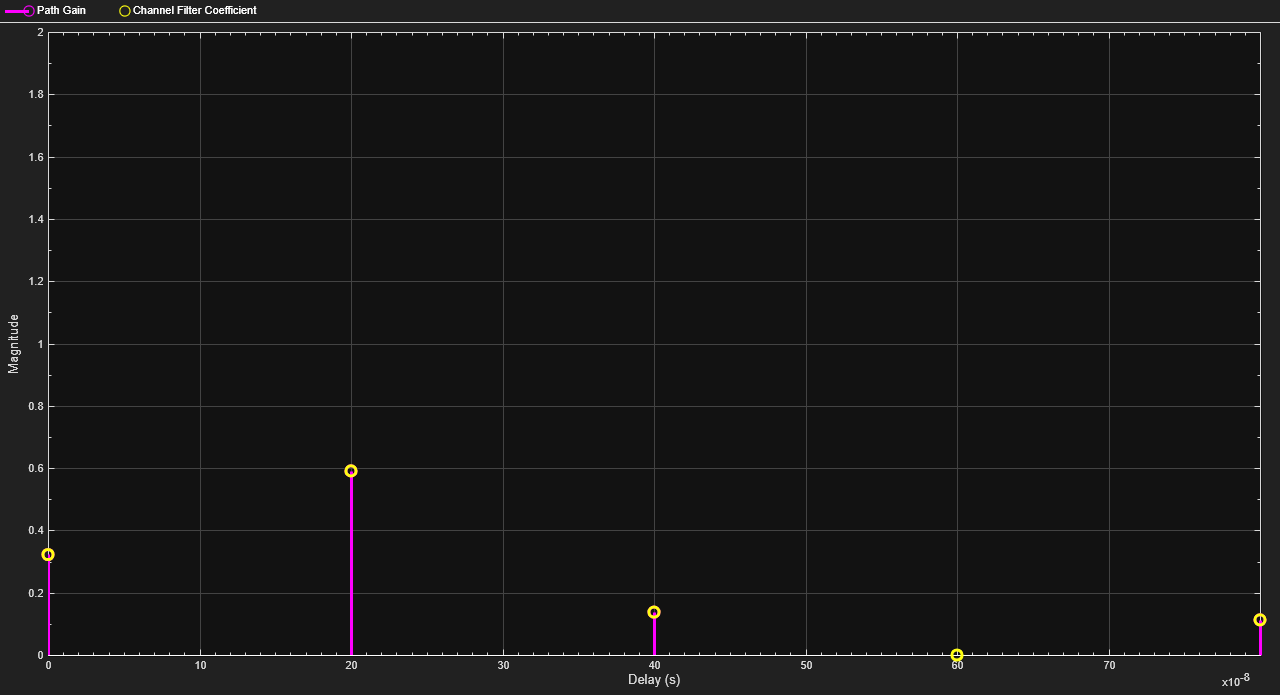
As displayed, the channel impulse response coincides with the path gains for this delay profile because the discrete path delays are all integer multiples of the input symbol period. In this case, there is also no channel filter delay.
Similarly, setting the Channel visualization parameter to 'Frequency response' shows the frequency response of the channel. You can also set Channel visualization to 'Impulse and frequency responses' to display both impulse and frequency responses side by side. You can see that the power level of the channel varies across the whole bandwidth.
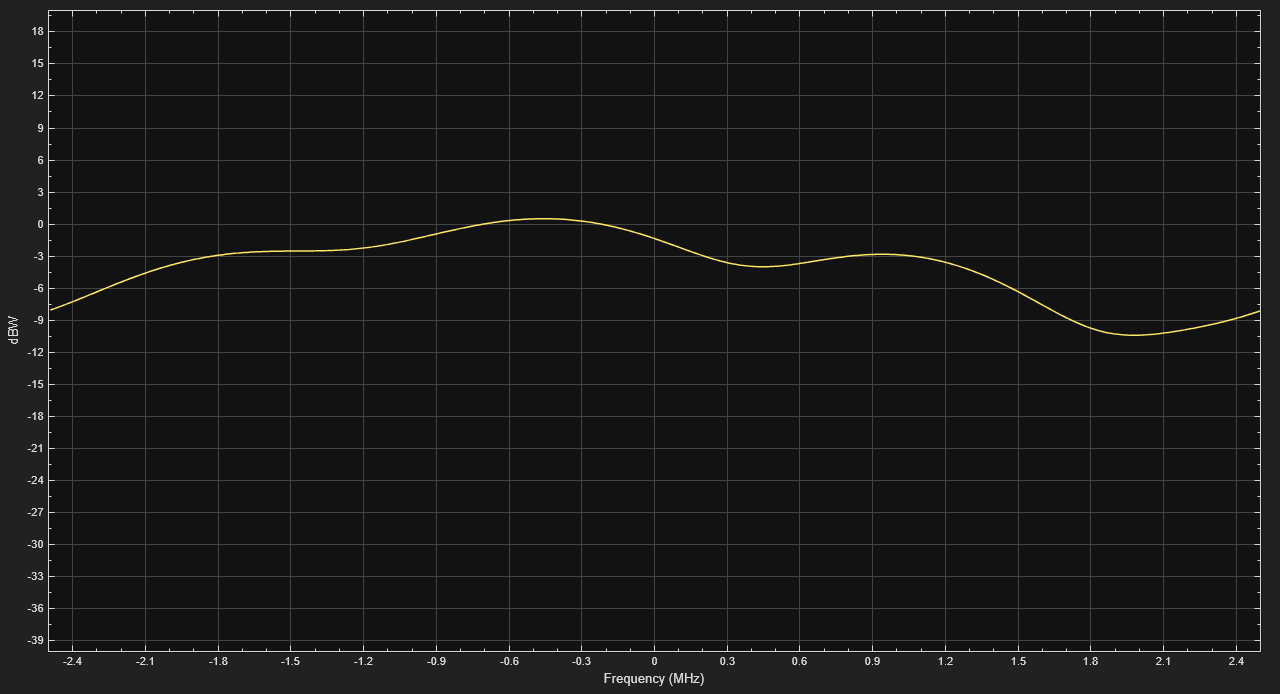
As shown in the channel visualization plots, you can also control the percentage of the input samples to be visualized by changing the Percentage of samples to display parameter of the channel block. In general, the smaller the percentage, the faster the model runs. Once the visualization figure opens, click the Playback button and turn off the Reduce Updates to Improve Performance or Reduce Plot Rate to Improve Performance option to further improve display accuracy. The option is on by default for faster simulation. To see the channel response for every input sample, uncheck this option and set Percentage of samples to display to '100%'.
For the same channel specification, we now display the Doppler spectrum for its first discrete path, which is a statistical characterization of the fading process. The channel block makes periodic measurements of the Doppler spectrum (blue stars). Over time with more samples processed by the block, the average of this measurement better approximates the theoretical Doppler spectrum (yellow curve).
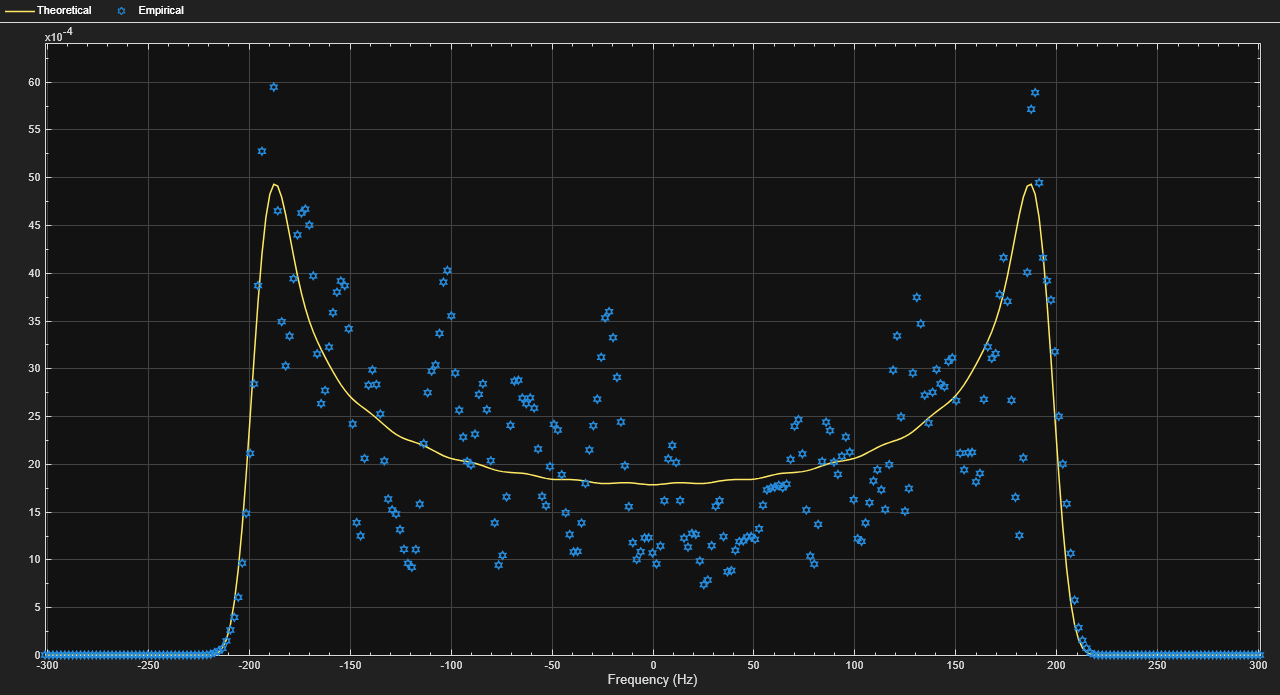
By opening the constellation diagram following the Rayleigh channel block, you can see the impact of wideband fading on the signal constellation. To slow down the channel dynamics for visualization purposes, we reduce the maximum Doppler shift to 5 Hz. Compared with the QPSK channel input signal, you can observe obvious distortion in the channel output signal, due to the ISI from the time dispersion of the wideband signal.
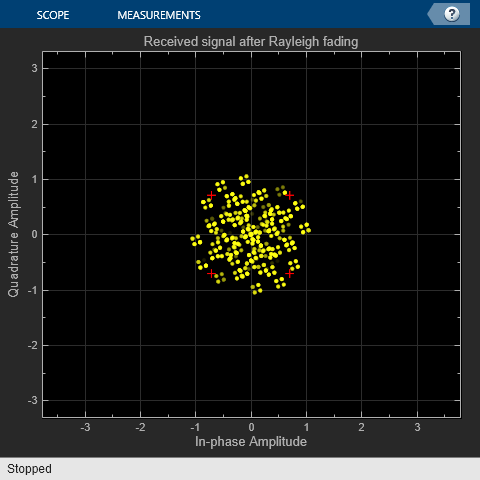
Narrowband or Frequency-Flat Fading
When the bandwidth is too small for the signal to resolve the individual components, the frequency response is approximately flat because of the minimal time dispersion and very small ISI from the impulse response. This kind of multipath fading is often referred to as narrowband fading, or frequency-flat fading.
To observe the effect, we now reduce the signal bandwidth from 10M b/s (5M sym/s) to 1M b/s (500K sym/s), so the delay span (0.8 microseconds) of the channel is much smaller than the QPSK symbol period (2 microseconds). Effectively, all delayed components combine at a single delay (in this case, at zero).
bitRate =
1000000
We can visually validate this narrowband fading behavior by setting the Channel visualization parameter to 'Impulse and frequency responses' for the Rayleigh channel block and then running the model.

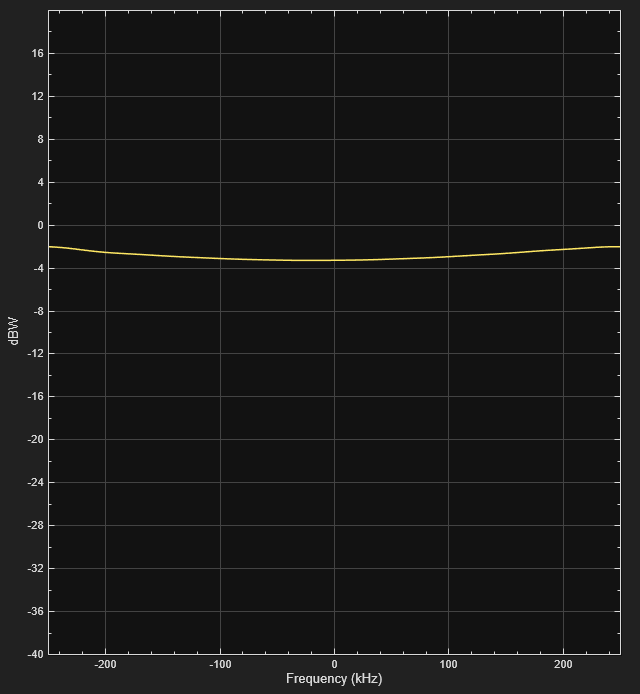
For narrowband fading channels, a single-path fading model can accurately represent the channel. To simplify and speed up simulations when the channel has narrowband fading, consider replacing a multipath fading model with a single-path fading model. The following settings correspond to a narrowband fading channel with a completely flat frequency response.


Return to the original four-path fading channel and observe how narrowband fading causes signal attenuation and phase rotation, by viewing the constellation diagram after the Rayleigh channel block. In addition to attenuation and rotation, you can see some signal distortion because of the small amount of ISI in the channel output signal. The distortion is far less than that seen above for a wideband channel.
Compare Path Gain Variation for Rician and Rayleigh Fading
The Rician fading channel block models line-of-sight propagation in addition to diffuse multipath scattering. This results in a smaller variation in the magnitude of path gains. Compare the variation between Rayleigh and Rician channels by reconfiguring the channel blocks to model a single-path delay. Use a Time Scope block to view the fluctuation of the path gain magnitude over the duration of the simulation. There is less than 5dB variation of the path gain magnitude for the Rician fading channel and close to 15 dB for the Rayleigh fading channel. For the Rician fading channel, this variation would be further reduced by increasing the K-factor (currently set to 10).
